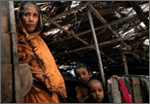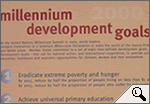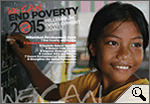|
|
|
|
 |
 |
 > Rich countries aren't helping enough > The spectre of hunger > The right to education dimarts, 21 de setembre de 2010
A global anti-poverty summit, attended by nearly one hundred and forty heads of state and government, is currently under way in New York. The summit was called by the United Nations General Assembly and aims to renew efforts to achieve the so-called Millennium Development Goals, agreed upon in the year 2000.
There are eight of these goals, which must be achieved before 2015. The first is the eradication of extreme poverty and hunger and, more specifically, to decrease by half the number of hungry people in the world, as well as those who live on less than a dollar a day. The other seven objectives are: to achieve universal primary education; promote gender equality; reduce child mortality; improve maternal health; combat AIDS, malaria and other diseases; ensure environmental sustainability; and develop a global partnership for development. According to the UN, there are countries that are in a position to meet these objectives thanks to the efforts undertaken in the last few years, however, many other countries are not moving in the right direction and the economic crisis (the worst since 1929) is complicating matters even further. Nonetheless, the UN has emphasised that the world has enough resources and knowledge to attain these goals. Yesterday, UN secretary Ban Ki-moon said that they are achievable and that the 2015 target date is still possible.
Rich countries aren't helping enoughBut in order to stick to this target date, rich countries must give more funds toward the development of poor countries. Last year they gave an average of 0.31% of their gross national product (GNI, the total sum of goods and services produced in a year), far from the 0.7% target established by the UN. Only five countries, all European, reached or exceeded this percentage: Denmark, Luxembourg, the Netherlands, Norway and Sweden.
The spectre of hunger
+ There are 925 million under-nourished people in the world (FAO Photo).
If we look at the first objective (the eradication of extreme poverty and hunger), a positive figure is that the poverty index in developing countries fell from 46% in 1990, to 27% in 2005. Yet in 2005 there were still 1,400 million people living below the poverty line (on less than 1.25 dollars a day). This is in addition to the effects of hunger, which today affects 925 million people, a greater number than ten years ago.
The right to educationWith regards to the goal of universal education, the progress made has been insufficient. The percentage of children attending primary education went from 83% in 2000 to 89% in 2008. However, there are still 69 million children that are unable to go to school. Almost half (31 million) live in Sub-Saharan Africa.
|
Investiga

> La fam, per regions.

> 'Què és possible, encara, de reduir la fam a la meitat?': estudi d'Intermón Oxfam.
I també...
- La fam, una xacra inacceptable.
- L'objectiu de l'ensenyament primari universal: situació actual.
Portada |
Europa Press |
El Punt |
La premsa |
Especials |
Diari de l'escola |
LesFinances.info |
Editorials |
Mail obert |
Els blocs |
Lletres
Tecnologia i ciència | Solidaritat | Cap de 7mana | Campus | El 9 | Presència | Fòrums | Enquestes | Xat | Correu
Traductor | Edicions en Pdf | Wap-pda | Biblioteca | Lletra més grossa
Tecnologia i ciència | Solidaritat | Cap de 7mana | Campus | El 9 | Presència | Fòrums | Enquestes | Xat | Correu
Traductor | Edicions en Pdf | Wap-pda | Biblioteca | Lletra més grossa
| Què és VilaWeb? Publicitat Mapa web Contacte | Una web de Partal, Maresma i Associats, S.L. |





